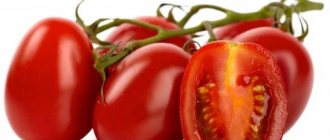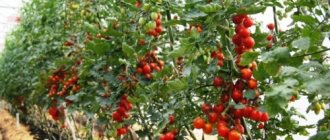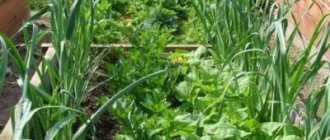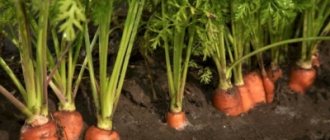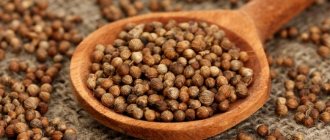Description of the mini carrot variety
Mini carrots are a special variety, distinguished by their miniature fruit and short ripening period. This vegetable is often called children's or baby carrots.
Reference. In some cases, mini-carrots are an ordinary root vegetable that has not reached its full size and is harvested before full maturity.
The best varieties of mini carrots
Among the variety of varieties, the following stand out:
- Caracas is an early cold-resistant variety. Suitable for cultivation on an industrial scale: the powerful leaf apparatus is convenient for harvesting with a pulling-type combine, the variety is undemanding in terms of thinning.
- Karotel is a mid-season, bolting-resistant variety. It takes 100-110 days from germination to full ripening. Suitable for winter sowing. Cone-shaped fruits from 9 to 15 cm long and weighing 80-160 g. They have good keeping quality and transportability.
- Marlinka is a mid-early variety (95 days). The length of the fruit is up to 10 cm, weight – 90-170 g. They have soft and juicy pulp.
- Polar cranberry is an early ripening (65 days) cold-resistant variety. Root vegetables of a non-standard round shape, like radishes. They have smooth thin skin with small eyes. Poor keeping quality, but excellent taste.
- Rondo is a hybrid of Czech selection. It takes 80-85 days from germination to harvest. The roots are small (3-5 cm), round in shape. Does not give arrows, is resistant to cracking.
- Khibiny greenhouse is an early ripening (54-70 days before harvesting bunched carrots, 90-100 days until full maturity) high-yielding variety, bred in the domestic Arctic. The root crop is round, small, weighing up to 35 g.
Origin and development
Mini carrots became popular in the early 1980s. Farmer Mike Yurozek from California (USA) was refused to sell a large batch of vegetables due to the fact that they were of substandard type - too thin, short, forked and twisted. To save the situation, the farmer peeled the carrots and cut them into small cylinders. In this form, the product was loved by many Americans, as it was completely ready for consumption.
This wave aroused interest in varieties of dwarf carrots that existed long before Yurozek’s “discovery”: Grelo, Davantyur. Subsequent work by breeders in different countries led to the modern variety of mini-carrots.
Chemical composition and beneficial properties
Baby carrots contain almost the same complex of vitamins and minerals as regular-sized root vegetables.
Mini carrots are rich in:
- beta-carotene – 10-13 mg per 100 g of product, which is 2-2.5 times the daily requirement of an adult;
- vitamin A – 2000 mcg;
- vitamin C – 5 mg;
- calcium – 27 mg;
- potassium – 200 mg;
- phosphorus – 55 mg;
- iron – 0.7 mg;
- copper – 800 mcg.
Unlike many other vegetable crops, carrots during heat treatment not only do not lose their beneficial properties, but increase them. Better absorption of microelements is facilitated by combining carrots with fats: dairy products or vegetable oils.
Reference. It is recommended to drink carrot juice with milk or cream before going out in the sun - the tan will acquire a beautiful shade.
Useful properties of carrots:
- Beta-carotene protects the skin from the harmful effects of ultraviolet radiation and is responsible for its healthy appearance and smoothness.
- Vitamin A improves vision.
- Carrots serve as a prophylactic for iron deficiency anemia.
- Indicated for diseases of the cardiovascular system, high blood pressure, atherosclerosis.
- Helps cope with vitamin deficiency.
Features of application
Mini carrots are good both raw and after heat treatment. It can be used in salads, soups, vegetable stews, purees, as a side dish or filling for pies. Fresh mini carrots are great as a snack and a healthy alternative to sweets.
Fresh mini-carrots appear in stores at the very beginning of summer; at other times of the year they are sold whole frozen or canned.
Reference. Glazed mini carrots are a favorite side dish for children in France. To prepare it, peeled root vegetables are mixed with water, honey and vegetable oil. Then simmer in a hot frying pan for 7 minutes. Sprinkle the finished dish with lemon juice and sprinkle with finely chopped fresh parsley.
Ripening time and yield
Depending on the variety, the growing season of the crop ranges from 50 to 110 days.
The small size of root crops does not prevent mini-carrots from producing a yield of 260 to 770 centners per 1 hectare of plantings.
Characteristics, description of appearance, taste
Mini carrots have a cylindrical fruit with a blunt tip. Fruit dimensions: 5-8 cm in length, 1.5-3 cm in diameter. At the same time, there are varieties with rounded roots. The high carotene content gives baby carrots their bright orange color.
Miniature root vegetables are juicy and sweet.
Disease resistance and climate requirements
Mini carrots are resistant to cracking, bolting, rot and leaf spot. The variety is characterized by great diversity, therefore it is suitable for cultivation in almost any climatic conditions:
- the Marlinka variety is suitable for the Central Black Earth Region;
- in the Middle Zone, the Urals and Siberia, the Caracas mini-carrot produces a harvest;
- With proper care, the harsh climate of the northern regions can be tolerated by Polar cranberry and Khibiny greenhouse.
"Polar Cranberry"
One of the earliest forms - only 65 days from sowing to harvest. Round specimens resemble large radishes. They have high resistance to cracking. Valued for ease of collection. The smooth surface is covered with small eyes. The head does not turn green. Suitable for fresh consumption, processing, storage and transportation. Often grown for early harvest for later sale.
The pulp is intensely colored, with a high content of sugars and dry substances. Due to its small size, the variety is suitable for preservation in its entirety. Pickled together with other small vegetables, they do not lose their taste, but give the appetizer more aroma and contrast.
Features of planting and growing
Growing mini carrots is in many ways similar to cultivating other varieties. The main feature is predominantly winter planting and a shorter growing season.
Preparing for landing
Seeds required before planting:
- Sort. This is easy to do by placing the seed material in a saline solution (1 teaspoon of salt per 1 cup of water). Discard specimens that float to the surface, and rinse the rest in running water and dry.
- Disinfect in a weak solution of potassium permanganate.
- When planting in regions with a cold climate, harden off: pour the seeds with water at room temperature, then place in the refrigerator for 3-4 days.
After each procedure, the seeds are dried so that they do not germinate ahead of time.
Soil requirements
Mini carrots are photophilous, so planting them requires a well-lit area. Other requirements include:
- good drainage, since the crop does not tolerate stagnant water;
- neutral soil acidity;
- fertile light soil - chernozem, loam or sandy loam are ideal; in other cases, humus and peat are added to the soil a month before sowing.
Predecessors
It is better to plant carrots in an area where nightshades (tomatoes, zucchini, potatoes) or cabbage were grown. After these plants, the soil is saturated with nutrients necessary for a rich harvest.
In former cucumber beds, carrots are sown no earlier than 2 years later, otherwise excess organic matter will lead to rotting of the plantings at an early stage.
Reference. Strong odors emanating from alliums - onions, garlic, wild garlic - can repel carrot flies. To protect root crops from this pest, they practice planting these plants together.
Other umbelliferous plants (the family to which carrots belong) - parsley, dill, caraway, parsnips and celery - are considered bad predecessors because of the danger of the proliferation of pathogenic fungi and bacteria.
Dates, scheme and rules of planting
For winter planting, choose the middle - end of November. Earlier planting is fraught with germination of seeds and the appearance of seedlings that will die when the first frost occurs. Overwintered mini-carrots will produce a harvest in June.
In regions with frequent thaws and recurrent frosts, spring planting is preferable. Choose a moment when the snow has already melted, but the soil has warmed up to no more than +8...+10°C. Depending on the climate zone, this may be the second half of April or May. Covering material will help protect crops from frost.
To get a harvest with good keeping quality, choose mid-season and mid-early varieties. The optimal time for planting them is May-June. The same period is suitable for re-sowing early varieties.
Important! Carrots do not tolerate excessively wet soil. About a month before planting, the area is covered with film to protect it from rain and melting snow.
Despite the miniature size of the root crops, it is recommended to maintain a distance between grooves of 2 cm and a seeding depth of 2-2.5 cm.
Nuances of care
Caring for carrot plantings includes watering, thinning and fertilizing the plants, protecting them from weeds, diseases and pests.
Watering mode
After the first shoots appear, watering is carried out once every 3 days, water consumption is 3 l/m². As the plant grows, the frequency of irrigation is reduced to once a week. In this case, about 10-15 liters of water are required per 1 m² of planting. A couple of weeks before harvesting, watering is stopped.
Reference. The best effect is achieved by watering in the morning or evening hours, when solar activity is reduced and the air is warmed up by no more than +20...+25°C.
Thinning and weed control
Weeds and dense planting interfere with the normal development of carrots. Therefore, immediately after the appearance of 2 true leaves, the beds are weeded and thinned at the same time. To achieve optimal density, leave a distance of 4-5 cm between plants.
Soil herbicides (Gezagard, Reglon Super) help reduce the number of weedings. The soil is treated with the preparations dissolved according to the instructions.
Top dressing
During the growing season of mini-carrots, 3 feedings are recommended:
- At the stage of 3-4 true leaves, the plant needs nitrogen and potassium fertilizers. For these purposes, a solution of 2 matchboxes of ammonium nitrate per 10 liters of water is suitable.
- After 2-3 weeks (the tops consist of 4-6 true leaves), fertilize with complex fertilizers, for example, nitrophoska - 2 matchboxes per 10 liters of water.
- During the growth phase of the root crop, there is an outflow of nutrients from the above-ground part. To form sweet and juicy fruits, phosphorus, boron and manganese are needed. Superphosphate (60-80 g per 10 liters of water) will help maintain the vitality of the plant.
To remove nitrates, 30 days before harvesting, you can fertilize the soil with potassium-containing preparations.
Disease and pest control
The main cause of plant diseases is violation of agricultural practices. As a rule, this is incorrect crop rotation, excessive watering without providing adequate drainage, dense plantings, the presence of weeds and insufficient loosening.
Carrots are most susceptible to fungal diseases:
- Phoma appears as dark brown spots on the tops, petiole and the root itself.
- Alternaria blight (dry or black spot) is characterized by dark spots, curling of the foliage and a bitter taste in the carrot pulp.
- Cercospora blight leads to darkening of the tops, deformation and shredding of root crops.
- Brown spotting is more common in young plants; the first sign is darkening of the tops at the base; as they grow, the leaves begin to turn yellow and acquire a brown color.
- Powdery mildew reveals itself by a characteristic white coating on plants.
- Rhizoctonia (felt rot) is a putrefactive coating on root crops, which gradually thickens and forms a crust.
Among bacterial diseases, bacteriosis especially often affects carrots: the lower part of the tops turns yellow, then brown areas form on the root crop.
The following drugs are used for treatment:
- decoctions of herbs (celandine, nettle, horsetail);
- Bordeaux mixture;
- copper oxychloride (CHOM);
- contact chemical fungicides - “Rovral” (“Iprodione”), “Skor” (“Difenoconazole”);
- biofungicides – “Fitosporin-M”, “Mikorad MALSANO” (“Trichodermin”).
Carrot flies, moths and psyllids are considered to be the worst pests of carrot plantings. Fight them with:
- industrial insecticides (Intavir, Karatan, Karate Zeon, Medvedox);
- folk remedies (tobacco-soap and saline solution, infusion of onion or garlic);
- repellent plants (calendula, marigold, onion, garlic);
- mulch between rows (wood ash, pine sawdust).
Harvest and storage
The ripeness of the root crop is determined by the condition of the ground part . The dying off of the lower leaves indicates the plant is ready for harvest. Also, the gardener should focus on the timing specified in the instructions for the seed material.
Harvest in dry weather - damp carrots will not be stored for long. If necessary, root vegetables are dried in the open air, hidden from direct sunlight under a tent.
Reference. Removing the tops helps to extend the shelf life - they are cut off or torn off with twisting movements.
Storage features and shelf life
Early varieties of mini-carrots have poor shelf life, so it is recommended to eat them as soon as possible after harvesting or prepare them in any available way: freeze, preserve or dry them.
More mature mid-season and mid-early varieties are Karotel and Marlinka. These carrots are stored in a cool, dry cellar for several months.
"Alenka"
Development of domestic seed. Late ripening form of the Berlicum variety. The root crop is long, cylindrical with a blunt tip. The weight of commercial specimens ranges from 120–190 g. The pulp and skin are bright orange. The pulp is high density, juicy, very tasty. Recommended for processing and storage.
The variety is valued for its stable yield and high carotene content in root crops. The declared yield is 5.5 kg/m² with intensive cultivation technology. If the soil used is not very fertile and timely thinning is not carried out, the figure will be 3–3.5 kg per square meter.
And today they continue to develop new varieties of mini-carrots. Thanks to them, as well as compliance with agricultural cultivation techniques, a delicious vegetable rich in vitamins can be harvested even on the windowsill.
Reviews of the mini carrot variety
Baby carrots received the well-deserved love of summer residents. Proof of this is their rave reviews.
Maria: “The little carrot is a real find! Minimum effort in growing and maximum pleasure on the plate. Little children gobble up these “short ones” by both cheeks!”
Ivan: “I’m desperate to grow carrots in our permafrost conditions (Murmansk region). I tried the Khibinskaya greenhouse variety - it feels great under the film, and tolerates temperature changes with a bang.”
